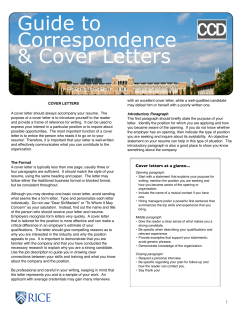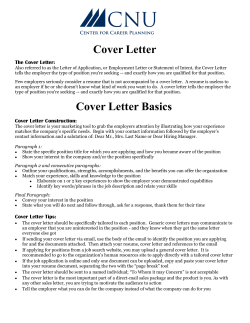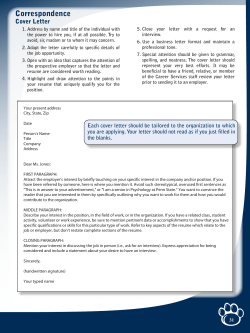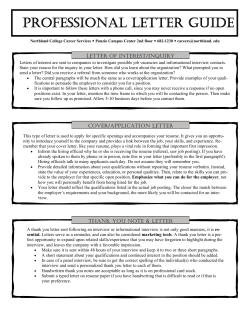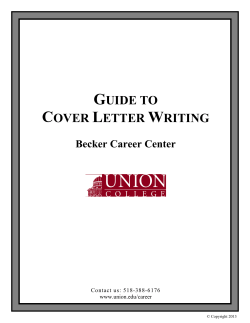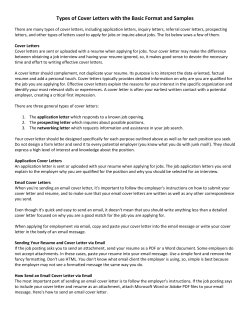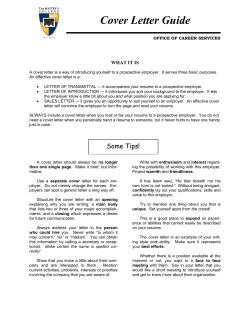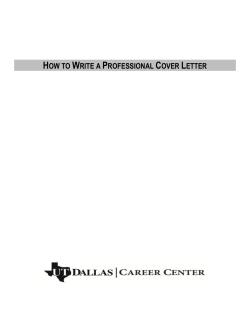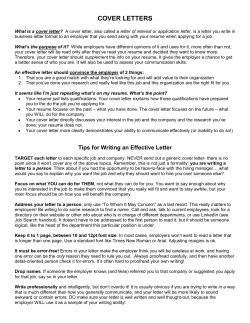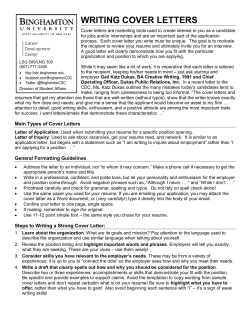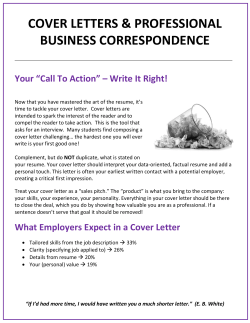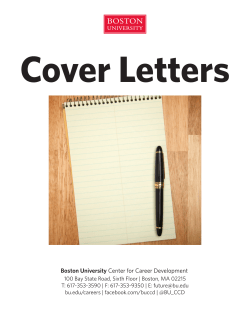
Cover Letters: 10 Steps to Success The Office of Career Services
Cover Letters: 10 Steps to Success Also includes: Thank You Letters Inquiry/Networking Letters The Office of Career Services www.rollins.edu/careerservices 407-646-2195 Cover letters are used as an effective means of introduction. Your cover letter allows you to present yourself, in narrative form, as the perfect candidate. Whenever you mail, email or fax your resume, it should almost always be accompanied by a one-page, targeted cover letter. The cover letter expands upon certain information on your resume that pertains to the specific position for which you are applying. It is your opportunity to highlight your most impressive and relevant experience. You will want to discuss how your experience meets the qualifications the organization is seeking in new employees. Imagine your cover letter as a marketing tool, much like a television or radio commercial. Effective commercials catch your attention by highlighting only the most attractive features of a product. Your cover letter should be your commercial, in which you highlight your most attractive features as a potential employee. Be brief. Avoid detailing your entire work history in your cover letter – save that for your resume. The best way to distinguish yourself is to highlight one or two of your accomplishments or abilities that show you are an above-average candidate for the position. Cover letters may not always be required when applying for internships, but are certainly appropriate to show a potential internship site that you are serious. When writing a cover letter to accompany your resume for an internship, you may not have much relevant experience to highlight. It is okay to instead describe your educational background or focus on your desire to work in the chosen industry or career field. This way, you can still demonstrate your sincerity and interest in the career field, even though you may be lacking relevant experience. You should write a different cover letter for EACH position to which you apply. Take time to research each employer and what they are looking for in potential candidates. Incorporate information from the job description into your cover letter to demonstrate that you have the skills the employer is seeking. If your cover letter is well written, it will lead the employer to the other part of your application – the resume. If your letter is poorly written, the employer may not even take the time to review your resume and your application has a good chance of ending up in the trash. When an employer opens the envelope or email attachment, the cover letter is the first thing seen. Be sure that first impression is a good one by following the steps below. Step One – The Basics Your cover letter should be printed on the same, high-quality white or off-white paper as your resume and use the same font style as well. A cover letter should be no longer than one-page in length and contain 3-4 short paragraphs. A busy employer will probably not read a long cover letter, squeezed onto one page with small fonts and shrunken margins. Your cover letter should appear neat, easy-to-read and appealing to the eye. Step Two – Business Format Two addresses should appear at the top of every cover letter you send; one belongs to you and the other to the person or organization receiving your letter. For your address, you have two choices. You may copy the heading style you used on your resume. For example, if your resume displays your name centered in large capital letters with your contact information directly underneath a thick black line, it is appropriate to have that same heading on the top of your cover letter. However, you may decide to head your cover letter in traditional business letter format, as discussed below. If you choose to write your cover letter in traditional business format, you will include your street address, city, state and zip code. 2 Underneath your address, skip one line and enter the current date (or the date you plan to mail the letter). Take time to spell out the entire month, no abbreviations, dashes or hyphens are allowed. Next, skip one line and enter the contact information for the person receiving your cover letter. Begin with the contact’s name, followed by his or her title, the department or division if appropriate, the name of the company, street address, city, state and zip code. In some cases, you may not know the name of the contact person, especially if you are responding to a public advertisement for a position. Do your best to find the name of the person responsible for hiring this position by searching the web and/or telephoning the main office. If the company will not provide you the name, simply omit the name and title from the address information and only include that which you know. Jennifer Job jennifer_job@yahoo.com Current: 1000 Holt Avenue - 2587 Winter Park, FL 32789 407-555-5555 Permanent: 3000 Dogwood Drive Troy, OH 45373 937-555-9999 January 15, 2011 James Brown Marketing Manager Talent Search/New Artist Division Soul Records 7922 Jazz Road Motown, FL 32855 1000 Holt Avenue – 2587 Winter Park, FL 32789 January 15, 2011 Talent Search/New Artist Division Soul Records 7922 Jazz Road Motown, FL 32855 Step Three – Salutation As discussed in Step Two, it’s important to address your cover letter to a specific person. Letters targeted at the appropriate hiring manager or human resources person are more likely to be read and received positively than letters mailed simply to “SunTrust” for example. Especially at a large organization, it is important that your cover letter finds its way into the hands of the right people. 3 Underneath the last line of the company address, you will skip one line and type “Dear Ms.” or “Dear Mr.” or “Dear Dr.” and enter the last name of your contact person, followed by a colon. Be careful to use the correct gender when addressing your cover letter and never use “Dear Mrs.” or “Dear Miss” in a formal business letter. If you do not have a specific contact name, there are a few options for addressing your letter: To whom it may concern: Dear Human Resources Director: Good Morning: Dear Sir or Madam: Dear Selection Committee: (only use if you know a group is involved in the hiring process) Dear Board of Directors: (only use if you know this is the group reviewing your application) Step Four – The First Paragraph Generally, you should begin your first paragraph by clearly stating the purpose of your letter. Why are you contacting this person (to apply for a job), which position are you applying for (name of position or department), and how did you hear about the opening, are questions that should be answered in the first few sentences of your letter. It is very impressive to an employer if you can demonstrate knowledge about their organization. For example, cite information that attracted you to the company or a specific reason why you desire to work there. Check out the company’s website and research local papers to see the latest news updates on the organization. Lastly, you want to include in the first paragraph a short statement that expresses your honest desire to work for the organization. Briefly, demonstrate that you are a worthy applicant and entice the employer to keep reading. Dear Ms. America: I am writing to apply for the Environmental Specialist position with The Nature Conservancy that is posted on the Rollins College Career Services website. I am motivated to pursue a career in the biological sciences and I feel confident that my education in Environmental Studies, international field studies trips and internship experiences make me a qualified candidate for this position. Dear Mr. Wilson: I am writing to apply for the position of Event Planner advertised in the Career Services Office at Rollins College. Through several recent articles in The Orlando Business Journal, I have learned about the rapid growth and success of Jackson Public Relations in this area, and I would like to know more about your organization’s unique approach to promotions and publicity. I am interested in joining your staff and making immediate, creative contributions. 4 Step Five – The Middle Paragraph(s) - Highlights ONLY! This is the part of the cover letter where you link yourself to a specific job category or type of work. Indicate your desire to work in the field and call attention to your strengths by highlighting one or two of your special accomplishments. If you feel as though some of your skills or experiences have not been well described on your resume, you can discuss those here. The second and optional third paragraph(s) of your cover letter tell more about yourself and why you’re the perfect candidate for the job. Be sure to link your skills to the needs of the company and the requirements for the position. The middle paragraph(s) allows you to move beyond your initial declared interest and competence to more revealing statements about who you are and what skills you bring to the job. This is your opportunity to draw attention to key facts in your work history or educational/training background. In the middle paragraph(s) you can also mention any connection or prior experience you may have with the company. It’s important to remember, however, that it is NOT sufficient to simply state what you believe to be true. You must show or demonstrate that truth. For example, your letter might say, “I am a hard-working, intelligent individual who is very creative and a good listener.” Well, anyone can say this and it may or may not be true. A successful cover letter will describe a job, a class or a group project where the candidate used and showed those skills. Don’t only claim to be very creative; also provide an example of something creative you did. If you are hard working, describe why or how you know that. Discuss the obstacles you have overcome. Explain a time when you worked really hard to achieve a goal and share how that project turned out. Your comments should always be backed up by specific references. Use examples of your success! I’m going to be the best employee SunTrust has ever seen. My energetic multitasking will be the ultimate asset to your company. Through my previous internships, I learned the skills of hard work, understanding people, communication, and good leadership. My undergraduate degree in psychology, combined with my four years of retail bicycle sales, and an internship with Rogers and Wells Public Relations would make me a strong addition to Gwinn Cycles’ marketing team. Meeting the demands of a full-time undergraduate education, a position as student government vice-president, and a 20-hour-a-week internship with Davidson Management provided me with the multitasking experience needed to excel as a financial analyst at Whittier Finance. I have worked with children as a caregiver for over eight years and throughout college served as the Social Chair for my sorority, Chi Omega. Caring for children, ages three through ten, challenged me to think of imaginative and clever ways to be engaging while maintaining a certain level of control. As my sorority’s Social Chair, I scheduled, planned and promoted several recreational activities for approximately 50 members. Both of these opportunities required me to be creative and communicate effectively with others. 5 Step Six – Final Paragraph The final paragraph is your fond farewell and the shortest paragraph in the letter. You should restate your interest in the position and thank the employer for reading your letter. It is appropriate to suggest a time when you’ll be getting in contact by phone or to indicate that you will wait for a response. Don’t forget to provide your telephone and/or email address again in this paragraph of the letter. The following are sample sentences you may include in your final paragraph: Thank you for your time. Thank you for reviewing my qualifications. Thank you for your consideration. I look forward to your reply. I look forward to hearing from you. I look forward to your response. I look forward to your call. Step Seven – Closing Although the closing of your cover letter will probably be just one simple word, it’s nonetheless an important part. Many candidates write impressive cover letters, only to ruin the overall impression with a horrible closing. It is NOT appropriate to use any of the following as a closing to your cover letter: See ya, Thanks a lot, With great honor and respect, Humbly yours, Always Yours, With Sincere Thanks and Heartfelt Appreciation, There are a few “tried and true” methods of closing your cover letter that are safe and effective. You might think these are boring, but boring is better than silly or cheesy. Career Services recommends you use a standard, traditional closing such as: Sincerely, With sincere regards, After typing your closing, skip three lines and type your full name (as it appears on the top of your resume). Step Eight – Your Signature This part is easy – DON’T FORGET TO SIGN YOUR NAME! Nothing looks worse than a letter with a big white space where the signature should be! Use blue or black pen, but don’t forget to sign! Emailed cover letters are exempt from this requirement. Simply typing your name underneath the closing is appropriate. Step Nine – Enclosures Underneath your typed name, skip one line and type the word “Enclosure”. This indicates that another document (probably your resume) is included in your application packet, which you have mailed to the employer. If the employer asked you to submit writing samples or a reference list, the word “Enclosures” should be followed by a number in parentheses indicating how many separate documents you have included with the cover letter. 6 Thank you in advance for your consideration. I hope I will be given the opportunity to contribute to the growth and success of the American Red Cross. I have enclosed my resume for your review. Please contact me by phone (407-555-2195) or by email at tjackson@gmail.com if you have any questions about my application materials or wish to arrange a meeting. I look forward to hearing from you soon. Sincerely, Tyler Jackson \ Enclosure I have enclosed my resume, which provides additional information about my experience and qualifications. I am extremely interested in this internship and would welcome the opportunity to interview with you at your convenience. I can be contacted at sjobsearcher@rollins.edu or (407) 555-3210. Thank you for your consideration. Sincerely, Sarah Job Searcher Enclosure I have thoroughly enjoyed my two public relations internships and believe these experiences, as well as my coursework and college activities, have prepared me to be a successful Event Planner at Jackson Public Relations. Enclosed are my resume and two writing samples for your review. I will contact you within the next two weeks to see if an interview may be arranged at your convenience. If you wish to reach me prior to that time, please contact me at bmcclendon@yahoo.com or 407-555-2195. Thank you in advance for your consideration. Sincerely, Brian McClendon Enclosures (3) Enclosures (3) 7 Step Ten – Do’s and Don’ts DO use spell check – misspelled words on a cover letter will almost certainly send your application packet straight to the bottom of the pile, if not the trash. DO proofread your letter several times. Spell check can’t always catch “their” vs. “there” and may not notice that you typed “Rolling” instead of “Rollins.” DO ask someone to proofread your cover letter. It’s always a good idea to have fresh eyes review your work to catch any small mistakes you may have missed. Don’t forget, Career Services can help! Drop off your cover letter in the office and pick it up the next day with plenty of tips and suggestions written in the margins. DO keep your cover letter brief. Busy employers do not want to read detailed, lengthy descriptions of your entire work history from age 12-present. Stick to the highlights and keep your cover letter on one page. DO use professional language. Remember, this is an employer’s first impression of you as a potential employee. DON’T hide your reasons for writing the letter down in the last paragraph. Begin your letter by telling the reader why you are writing. DON’T begin your letter with something like, “Hi, My name is Sam Smith and…” The employer can read your name at the bottom in the signature. DON’T overuse the thesaurus. Speak in everyday language that is clear, easy to understand, and professional. If you don’t really know the meaning of a word, don’t use it in your letter! DON’T use the same cover letter every time you submit a resume. Tailor your letter to be specific to the job for which you are applying. See back of this page for Thank You and Networking Letters. 8 Thank You Letters Each time you have a personal contact with a potential employer you should send a thank you letter. Most often sent after an interview, the thank you letter can be used to enhance your candidacy. Your letters should: 1) express your appreciation for the interview, 2) emphasize your interest in the position, 3) re-emphasize your skills, and 4) provide additional information regarding your qualifications you may not have mentioned earlier. A well-written thank you letter can provide you with an edge in the interview process. As a general rule, thank you letters should be sent within 24 hours of your interview. If you suspect the employer will make a hiring decision before receiving your letter in the mail, you may wish to email him/her a formal thank you letter. Whether you email or mail your thank you note, be sure to write it in a traditional, business style format. During the course of a formal interview, you may meet with several individuals. Be sure to collect business cards and send a separate thank you letter to each person who has input in the hiring decision. Each letter should have a slightly different message, depending on the scope of your discussion with that individual. Whenever possible, try to add a small personal touch or mention a specific topic that was discussed just between the two of you, as a way to personalize each letter. It is also appropriate to send thank you letters to other individuals who have assisted you in the job search process. These individuals may include professors who have written reference letters, alumni career contacts, and your friends and acquaintances who have provided information or advice. Handwritten note cards are appropriate for acquaintances (including faculty) who have assisted you in your job search process, but alumni, employers, and others should receive formal, typed thank you letters on high-quality resume paper (or, a formal thank you note via email, depending on the hiring timeline). To review sample thank you letters, please visit the Resumes and Cover Letters section of the Career Services website and click the “Samples” link at the top of the page. Inquiry/Networking Letters The inquiry or networking letter is generally used when you are seeking an informational interview. Often, you may request this type of meeting over the phone or through email. However, these general guidelines still apply. Your inquiry or networking letter should be brief in nature. This form of letter states your interest in meeting with an individual to learn about a specific career field and related job search techniques. It is important to stress that you are looking for advice and information only. You are not, at this point, seeking a job interview. In the letter, briefly introduce yourself and explain your desire to speak with this contact. You may want to discuss how you found his/her contact information (from the company website or through the alumni Career Connections system for example). Explain that you will call to determine if an informational interview may be arranged. A resume is not typically included with this form of letter, but can be presented during the meeting to assist the employer in responding to your questions regarding qualifications. To review a sample inquiry/networking letter, please visit the Resumes and Cover Letters section of the Career Services website and click the “Samples” link at the top of the page. 9 Sample Cover Letter 1000 Holt Avenue- 2587 Winter Park, FL 32789 April 11, 2012 Dr. Jillian Johnson Assistant Superintendent Green County Schools 123 Zippy Lane Miami, FL 12345 Dear Dr. Johnson: Please accept this letter of application for the fourth grade instructional position that is currently available in the Green County School System. I learned of the opening through a notice posted on the Rollins College, Office of Career Services website. I am confident that my academic background and curriculum development skills would be successfully utilized in this teaching position. I have just completed my Bachelor of Arts degree in Elementary Education and am eligible for the State of Florida Teacher Certification in Elementary Education (K-6). During my comprehensive student teaching internship, I developed and initiated a three-week curriculum sequence on animal species and earth resources. This collaborative unit involved working with three other third grade teachers within my team, and culminated in a field trip to Sea World’s Animal Research Unit. In my work with the third grade classes, I stressed critical thinking and the incorporation of mathematical and science units into the course. The student response was very encouraging, as we had a 100% passing rate for this section. In addition, our team met state curricula guidelines and received numerous positive calls from students’ families regarding the class material. Both my cooperating teacher and my supervisor from the teacher preparation program complimented me on my enthusiastic classroom presentations. Please consider this resume as an expression of my sincere interest in pursuing any fourth grade vacancies that may arise in your district. I will create a productive learning environment that is student-centered. If you have any questions, I may be reached at ssmith@gmail.com or (407) 555-2195. I welcome the opportunity to interview for a position with the Green County School District. Thank you for your consideration. Sincerely, Susan M. Smith Enclosure 10 Sample Cover Letter 1000 Holt Avenue – 2587 Winter Park, FL 32789 October 20, 2011 Ms. Myra Rogers Director Orange County Historical Museum 812 East Rollins St. Orlando, FL 32788 Dear Ms. Rogers: Through Career Services at Rollins College, I learned that you have a Spring 2012 internship available in historical research. I am very interested in this internship and feel confident in my abilities to perform the outlined responsibilities. Throughout my life, I have been greatly interested in all aspects of American history. I was a docent at the Charleston Architecture Museum and volunteered to give tours and answer questions from tourists. As Treasurer of the Civil War Re-enactors Club, I helped raise funds for traveling expenses to Fort Sumter to research the battle. I also studied the politics of antebellum Charleston and the atrocities of the slave trade. When I worked as a camp counselor at Grandfather Mountain Wilderness Retreat, I performed historical research on Appalachian culture that is currently utilized by the Linville Historical Society. As an intern, I would be able to use the skills I gained from these experiences to assist in the research of exhibits and the planning of programs and events at the Orange County Historical Museum that would appeal to diverse interests. I have enclosed my resume, which provides additional information about my experience and qualifications. I am extremely interested in the internship and would welcome the opportunity to interview with you at your convenience. I will call you next week to verify receipt of my application materials. If you would like to contact me prior to that time, I can be reached at jsmith@rollins.edu or (901) 555-3800. Thank you for your consideration. Sincerely, John Smith Enclosure 11 Sample Cover Letter JANICE JACKSON jan_jackson@hotmail.com 250 Broad Street • Columbus, OH 43201 • 614-335-8899 April 15, 2012 Andrew Patterson American Red Cross 2525 Tulip Lane Washington, DC 20006 Dear Mr. Patterson: Please accept this letter of application for the communication and marketing position listed on your organization’s website. I am motivated to pursue a career in the non-profit sector based on my past volunteer experience and am confident I have the qualifications required to help the American Red Cross succeed. As a student at Rollins College, I participated in several local Habitat for Humanity projects and witnessed the completion of two separate homes built for deserving families. In collaboration with other students, I helped Habitat for Humanity raise an extra $100 to purchase a few small toys for the children moving into the new home. Working with the project leaders at each house site, I realized the important role that non-profit employees play in recruiting and motivating dedicated volunteers. In addition to my community service experience with Habitat for Humanity, I have also worked with children as a caregiver and served as the Social Chair for my sorority, Chi Omega. Caring for children, ages three through ten, challenged me to think of imaginative and clever ways to engage and entertain them. As my sorority’s Social Chair, I scheduled, planned and promoted several recreational activities for approximately 50 members. Both of these opportunities required me to be creative and communicate effectively with others. I am comfortable speaking to all types of audiences and enjoy working as a team to accomplish goals. Thank you in advance for your consideration. I hope I will be given the opportunity to contribute to the growth and success of the American Red Cross. I have enclosed my resume for your review. Please contact me by phone (407-555-2195) or by email at jan_jackson@hotmail.com if you have any questions about my application materials or wish to arrange a meeting. I look forward to hearing from you soon. Sincerely, Janice Jackson Enclosure 12
© Copyright 2025


